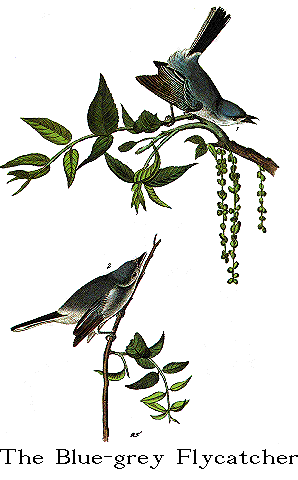Birds of America
By John James Audubon, F. R. SS. L. & E.
VOLUME I.



Family
Genus

THE BLUE-GREY FLYCATCHER.
[Blue-gray Gnatcatcher.]
CULICIVORA COERULEA, Lath.
[Polioptila caerulea.]

PLATE LXX.--MALE AND FEMALE.
This diminutive lively bird is rendered peculiarly conspicuous by its being
frequently the nurse or foster-parent of the young Cow Bunting, the real mother
of which drops her egg in its nest. A few individuals of this species remain in
Louisiana during spring and summer, and breed there; but the greater number
proceed far eastward, and spread over the United States, although they are not
common in any part.
The Blue-grey Flycatcher arrives in the neighbourhood of New Orleans about
the middle of March, when it is observed along the water-courses, flitting about
and searching diligently, amidst the branches of the golden willow, for the
smaller kinds of winged insects, devouring amongst others great numbers of
moschettoes. Its flight resembles that of the Long-tailed Titmouse of Europe.
It moves to short distances, vibrating its tail while on wing, and, on
alighting, is frequently seen hanging to the buds and bunches of leaves, at the
extremities of the branches of trees. It seldom visits the interior of the
forests, in any portion of our country, but prefers the skirts of woods along
damp or swampy places, and the borders of creeks, pools, or rivers. It seizes
insects on wing with great agility, snapping its bill like a true Flycatcher,
now and then making little sallies after a group of those diminutive flies that
seem as if dancing in the air, and cross each other in their lines of flight, in
a thousand various ways.
When it has alighted, its tail is constantly erected, its wings droop, and
it utters at intervals its low and uninteresting notes, which resemble the
sounds tsee, tsee. It seldom if ever alights on the ground, and when thirsty
prefers procuring water from the extremities of branches, or sips the rain or
dew-drops from the ends of the leaves.
Its nest is composed of the frailest materials, and is light and small in
proportion to the size of the bird. It is formed of portions of dried leaves,
the husks of buds, the silky fibres of various plants and flowers, and light
grey lichens, and is lined with fibres of Spanish moss or horsehair. I have
found these nests always attached to two slender twigs of willow. The eggs are
four or five, pure white, with a few reddish dots at the larger end. Two broods
are reared in a season. The young and old hunt and migrate together, passing
amongst the tops of the highest trees, from one to another. They leave the
State of Louisiana in the beginning of October, the Middle States about the
middle of September. I have seen some of these birds on the border line of
Upper Canada, along the shores of Lake Erie. I have also observed them in
Kentucky, Indiana, and along the Arkansas river.
In the plate is represented, along with a pair of these delicate birds, a
twig of one of our most valuable trees, with its pendulous blossoms. This tree,
the black walnut, grows in almost every part of the United States, in the
richest soils, and attains a great height and diameter. The wood is used for
furniture of all sorts, receives a fine polish, and is extremely durable. The
stocks of muskets are generally made of it. The black walnut is plentiful in
all the alluvial grounds in the vicinity of our rivers. The fruit is contained
in a very hard shell, and is thought good by many people.
BLUE-GREY FLYCATCHER, Muscicapa coerulea, Wils. Amer. Orn.,
vol. ii. p. 164.
SYLVIA COERULEA, Bonap. Syn., p. 85.
BLUE-GREY SYLVAN FLYCATCHER, Muscicapa coerulea, Nutt. Man.,
vol. i. p. 297.
BLUE-GREY FLYCATCHER, Muscicapa coerulea, Aud. Orn. Biog.
vol. i. p. 431.
Upper parts bright blue, deeper on the head, paler on the tail-coverts; a
narrow black band on the forehead, extending over the eyes; wings
brownish-black, margined with blue, some of the secondaries with bluish-white;
tail glossy black, the outer feather on each side nearly all white, the next
with its terminal half, and the third with its tip of that colour; lower parts
greyish-white. Female similar, but with the tints duller, and the black band on
the head wanting.
Male, 4 1/2, 6 1/2.
From Texas northward. Abundant. Migratory.
THE BLACK WALNUT.
JUGLANS NIGRA, Willd., Sp. Pl., vol. iv. p. 456. Pursch, Flor. Amer.,
vol. ii. p. 636. Mich., Arbr. Forest. de l'Amer. Sept., vol. i. p. 157,
pl. 1.--MONOECIA POLYANDRIA, Linn.--TEREBINTHACEAE, Juss.
This species belongs to the division with simple, polyandrous male catkins,
and is distinguished by its numerous ovato-lanceolate, subcordate, serrated
leaflets, narrowed towards the end, somewhat downy beneath, as are the petioles,
its globular scabrous fruits, and wrinkled nuts. The leaves have seven or eight
nearly opposite pairs of leaflets. The male catkins are pendant. The fruits
are sometimes from mix to eight inches in circumference, the kernel brown and
corrugated, and, although eaten, inferior to the common walnut. The bark of the
trunk is thick, blackish, and cracked; the wood of a very dark colour.









